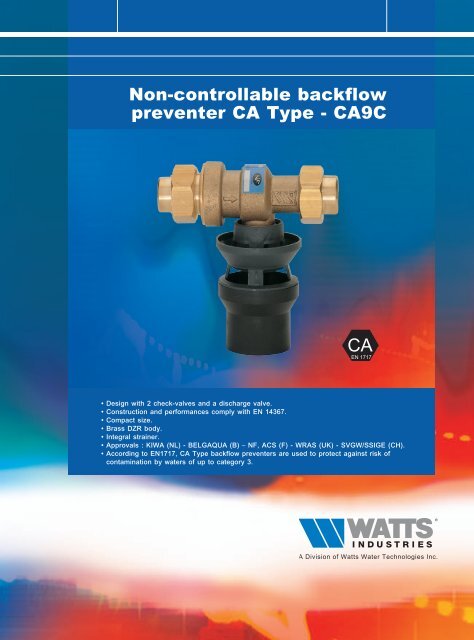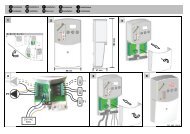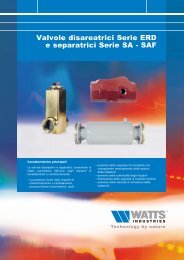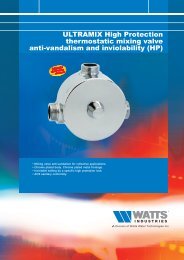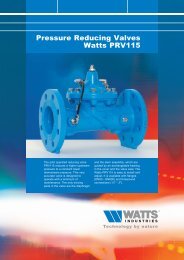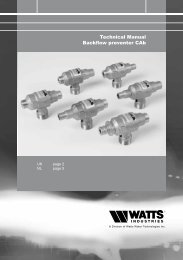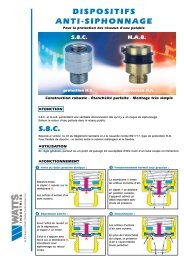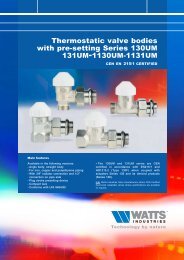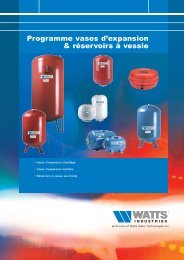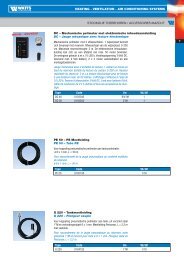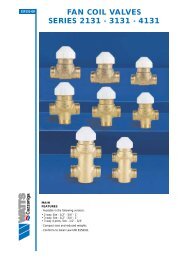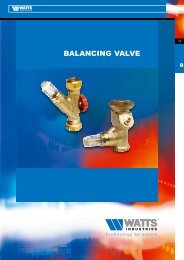Non-controllable backflow preventer CA Type ... - Watts Industries
Non-controllable backflow preventer CA Type ... - Watts Industries
Non-controllable backflow preventer CA Type ... - Watts Industries
Create successful ePaper yourself
Turn your PDF publications into a flip-book with our unique Google optimized e-Paper software.
<strong>Non</strong>-<strong>controllable</strong> <strong>backflow</strong><br />
<strong>preventer</strong> <strong>CA</strong> <strong>Type</strong> - <strong>CA</strong>9C<br />
• Design with 2 check-valves and a discharge valve.<br />
• Construction and performances comply with EN 14367.<br />
• Compact size.<br />
• Brass DZR body.<br />
• Integral strainer.<br />
• Approvals : KIWA (NL) - BELGAQUA (B) – NF, ACS (F) - WRAS (UK) - SVGW/SSIGE (CH).<br />
• According to EN1717, <strong>CA</strong> <strong>Type</strong> <strong>backflow</strong> <strong>preventer</strong>s are used to protect against risk of<br />
contamination by waters of up to category 3.
NON-CONTROLLABLE BACKFLOW PREVENTER <strong>CA</strong> TYPE<br />
Application :<br />
The <strong>CA</strong>9C is a <strong>backflow</strong> <strong>preventer</strong> for the protection of drinking water systems<br />
(main public system or private system). A <strong>backflow</strong> <strong>preventer</strong> is a sanitary device<br />
which is able to stop <strong>backflow</strong> of polluted water into the water system.<br />
<strong>CA</strong>9C is designed with 2 check-valves separated with a zone connected to the<br />
atmosphere. In case of upstream pressure loss or downstream overpressure<br />
(with leaking second check-valve), <strong>CA</strong>9C discharges by venting the middle zone<br />
to the atmosphere, this feature prevents any <strong>backflow</strong> polluted water in the device.<br />
Please refer to European Standard EN1717 or local regulation outside Europe<br />
for a proper use of the <strong>CA</strong> <strong>Type</strong> <strong>backflow</strong> <strong>preventer</strong>.<br />
Features :<br />
- Construction and performances comply with EN14367.<br />
- Compact size.<br />
- Brass DZR body.<br />
- Integral strainer.<br />
Operating principle:<br />
<strong>CA</strong>9C is a non-<strong>controllable</strong> reduced pressure zone <strong>backflow</strong> <strong>preventer</strong>, designed with 2 check-valves and a<br />
discharge valve. The pressure in the intermediate chamber (named “reduced pressure zone”) is always lower<br />
than the pressure upstream due to the head loss of the first check-valve. The closing of this chamber is due to a<br />
closing system linked to the upstream valve.<br />
1. Normal operation with flow: the two check valves are<br />
open allowing the flow of the water, the discharge<br />
valve remaining closed.<br />
2. Stop of the flow; static pressure: the device is<br />
under pressure, the two check valves are now closed,<br />
and the discharge valve remains closed due to the<br />
difference in pressure that still exists between the<br />
upstream pressure and the intermediate zone.<br />
3. Backflow conditions: in case of pressure loss upstream,<br />
the two check valves are closed, the depression<br />
causes the opening of the discharge valve and the venting<br />
of the intermediate zone. In case of downstream<br />
overpressure (pressure increase downstream), the<br />
second check valve is closed prohibiting all water returns.<br />
4. If exceptionally the second check valve downstream<br />
is failing, the discharge valve opens to evacuate<br />
the polluted fluid. This device is built as a positive<br />
acting device and maintains a high level of safety<br />
in all situations.
NON-CONTROLLABLE BACKFLOW PREVENTER <strong>CA</strong> TYPE<br />
Approvals :<br />
NF P 43 009 (pr EN 14367), ACS, KIWA, WRAS, SVGW, BELGAQUA.<br />
Technical specifications :<br />
Nominal diameter : DN 15, DN 20.<br />
Connections : FF 1/2”, MM 1/2”, FF 3/4”,<br />
MM 3/4”, F1/2”/M1”.<br />
Working pressure : PN10.<br />
Min. pressure : 1 bar.<br />
Max. temperature : 65°C.<br />
Connection tundish : Ø 40.<br />
Medium : clear water.<br />
Materials:<br />
description<br />
materials<br />
Body<br />
CuZn35Pb2Al-B (CB752S)<br />
Valve piston and Inlet fitting<br />
CuZn36Pb2As (CW602N)<br />
Sockets and fittings<br />
CuZn39Pb3 (CW614N)<br />
Nuts<br />
CuZn39Pb3 (CW614N)<br />
Spring Stainless steel 1.4310<br />
Membrane<br />
NBR (Nitrile)<br />
Valve gasket and check-valve gasket NBR (Nitrile)<br />
Check-valve<br />
POM (PolyAcetal, "Hostaform")<br />
Dimensions & range:<br />
F/F 1/2” (15x21)<br />
ref. code : 30115<br />
M/M 1/2” (15x21)<br />
ref. code : 30125<br />
F/F 3/4” (20x27)<br />
ref. code : 30215<br />
M/M 3/4” (20x27)<br />
ref. code : 30225<br />
F 1/2” (15x21)/M 1” (26x34)<br />
ref. code : 30138<br />
diameter type finish ref. code<br />
F/F 1/2” (15x21) <strong>backflow</strong> <strong>preventer</strong> <strong>CA</strong>9C + air gap self colour brass 30115<br />
M/M 1/2” (15x21) <strong>backflow</strong> <strong>preventer</strong> <strong>CA</strong>9C + air gap self colour brass 30125<br />
F/F 3/4” (20x27) <strong>backflow</strong> <strong>preventer</strong> <strong>CA</strong>9C + air gap self colour brass 30215<br />
M/M 3/4” (20x27) <strong>backflow</strong> <strong>preventer</strong> <strong>CA</strong>9C + air gap self colour brass 30225<br />
F 1/2” (15x21) / M 1” (26x34) <strong>backflow</strong> <strong>preventer</strong> <strong>CA</strong>9C + air gap self colour brass 30138<br />
Flow rate :<br />
Flow m 3 /h
NON-CONTROLLABLE BACKFLOW PREVENTER <strong>CA</strong> TYPE<br />
Fitting instructions:<br />
• The <strong>backflow</strong> <strong>preventer</strong> <strong>CA</strong> must be installed by qualified technicians in accordance with the instructions given in<br />
the packaging and following current local regulations.<br />
• The <strong>backflow</strong> <strong>preventer</strong> <strong>CA</strong> must be installed horizontally after an isolating valve (with draining tap) upstream and<br />
an inspectable strainer, another isolating valve must be installed downstream.<br />
• The device must be installed in an accessible area that is large enough to prevent it getting submerged by any accidental<br />
flooding.<br />
• Provide a suitable pipe to drain the evacuation of the fluid which the device could possibly drain.<br />
• Check the discharge pipe to ensure you of the correct operation of the flow.<br />
• During installation it is necessary to respect the direction of flow indicated by the arrow on the body of the device.<br />
• For the protection of the public main water supply, the <strong>backflow</strong> <strong>preventer</strong> must be installed after the water meter,<br />
whereas in order to protect the private internal water network, it should be installed at the limit of the areas where<br />
there may be contamination, for example: filling of the central heating …<br />
Installation:<br />
A. Assemble the <strong>CA</strong> 9C after the water supply system has been cleaned and rinsed.<br />
B. Install the <strong>CA</strong> 9C horizontally. The <strong>CA</strong> 9C <strong>backflow</strong> protection device must be installed in such a manner that it can<br />
be easily accessed for inspection, for checking the proper functioning, and for maintenance purposes.<br />
C. A shut off valve and/with draining device must be installed in front of the <strong>CA</strong> 9C.<br />
D. The relief opening must be connected to a discharge pipe of Ø 40 mm via the enclosed funnel.<br />
E. In case of installation without a discharge pipe, the <strong>CA</strong> 9C should be installed at a height of at least 30 cm above<br />
the drain.<br />
F. It is possible that after installation and commissioning of the installation, the drain opening may leak some water,<br />
until the valve seats have settled in place. Leakages may also occur if due to insufficient flushing of the pipeline<br />
network, contaminants are not properly removed.<br />
Maintenance:<br />
The <strong>backflow</strong> <strong>preventer</strong> is a health protection safety device and therefore requires periodical inspection.<br />
<strong>Watts</strong> <strong>Industries</strong> recommends that the <strong>CA</strong> <strong>backflow</strong> protection device should be inspected at least once a year.<br />
The first indication of malfunction, generally caused by foreign debris (sand, copper or calcium…), is revealed with a<br />
permanent leak from the drain.<br />
In the case of leakage at the drain, it is recommended to generate a major flow of circulation by opening some taps<br />
for a few minutes: this is often sufficient to expel any foreign debris and bring everything back to normal situation.<br />
This leak is merely an early warning and definitely does not put the safety of the device at risk, but it requires removing<br />
and cleaning the device and the upstream strainer.<br />
Test :<br />
Aim : To check the leak-tightness of the second non-return<br />
valve. This valve must remain leak-tight under all types of<br />
counter-pressures.<br />
Execution : 1. Close the shut off valve<br />
2. Open the draining device.<br />
If the water continues to drip, this indicates leakage/contamination<br />
of the second non-return valve. In this test, it has been<br />
assumed that downstream pressure is present.<br />
1 2<br />
The photographs, illustrations and descriptions contained in this brochure are given for information only.<br />
<strong>Watts</strong> <strong>Industries</strong> reserves the right to change the technical specifications or the design of these products without prior notice.<br />
WATTS INDUSTRIES France<br />
06, avenue Gustave Eiffel - B.P. 40339<br />
28006 CHARTRES Cedex (France)<br />
Tel. +33 (0)2 37 25 11 00 - Fax +33 (0)2 37 25 11 11<br />
E-mail info@wattsindustries.fr<br />
Site www.wattsindustries.com<br />
Re-order no. 51(3)-UK-08/03


